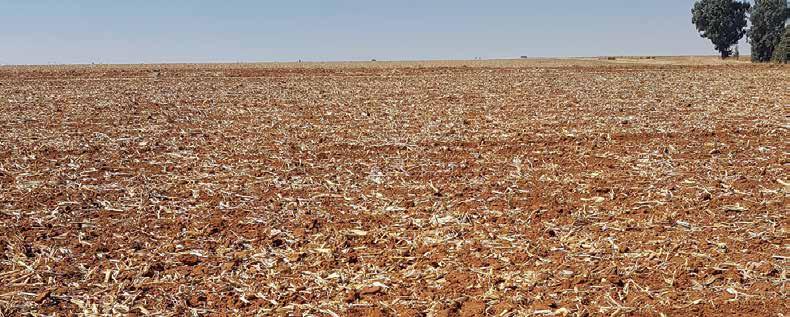
7 minute read
De Wittekrans mine gears up
Targets coal delivery in Q3
By Nelendhre Moodley

At a time when new investment in coal mining is seemingly suspended in inaction, coal exploration and mining company Canyon Coal’s latest project, De Wittekrans, is in the starting blocks, getting ready to deliver first coal in the third quarter of this year. Kobus Rothmann, Menar Group project manager, tells SA Mining about it in an exclusive interview.
De Wittekrans is a greenfield coal project located south of Hendrina in Mpumalanga. The area is home to two large power stations – Arnot and Hendrina – operated by power utility Eskom.
“De Wittekrans is important since Canyon Coal requires a constant stream of new projects to replace other operating mines that have or will come to the end of their life. Two mines (Singani and Hakhano) were mined out in 2019 and need to be replaced in order to fully utilise the related investments the company has made in securing sidings and export allocations,” says Rothmann.
Aside from being a key project for Canyon Coal, De Wittekrans o ers much value to the Mpumalanga area, which has an extremely high unemployment rate, as it is set to provide much-needed employment opportunities to the communities surrounding the project.
De Wittekrans is scheduled to employ 320 people, including contractors. According to Rothmann, where possible all labour will be sourced locally and trained, in most cases, by service providers and equipment suppliers.
“De Wittekrans will play an important role in the economy as it is set to supply reasonably priced coal to nearby Eskom power stations and generate substantial foreign exchange for the country through export opportunities,” says Rothmann.

Canyon Coal’s Bekezela project.
R1.6-billion
Capex for the development of De Wittekrans
PROJECT DEVELOPMENT
During 2020, the De Wittekrans project received its mining right, water-use licence and environmental authorisation, signalling the green light for project development.
“The project has all the statutory approvals in place and is in the final design phase. Some of the processes to bring utilities to site are also under way, as is the sourcing and preparation for the establishment of the washing plant,” says Rothmann.
De Wittekrans will be developed initially as an opencast mine (Phase 1), with an economically minable reserve of 14.3 million tonnes of run of mine (RoM), while Phase 2 will comprise underground operations and host 106.5 million RoM tonnes.
According to Rothmann, the opencast operation will start mining at a depth of 17m extending to 160m below surface for the underground operation.
The project is set to produce 5 700kcal primary product with a 4 800kcal secondary product, over its estimated life of mine (LoM) of around 25 years. The LoM is based on an RoM production of about 300 000t/m.
The start-up capital expenditure for the estimated R1.6-billion project is around R730m, which consists largely of capex for development of the opencast operations and associated infrastructure – this will be funded from Canyon Coal’s own resources.
But the project, which is well placed between two key power stations in Mpumalanga, is yet to ink an o take agreement with the local power producer.
“Canyon Coal does not currently supply any coal to Eskom. There are, however, plans to supply Eskom in the future from new projects.”
De Wittekrans is one of the new projects Canyon Coal has planned for this year. “The project’s locality makes it suitable for export and Eskom supply. Although tenders have been submitted to supply Eskom, this has not been finalised,” says Rothmann.
Mining investment company Menar has controlling stakes in Canyon Coal, Zululand Anthracite Colliery, Kangra, and East Manganese.

CANYON COAL OPERATIONS
Canyon Coal currently produces 2.57 million saleable tonnes, with about 70% of the coal destined for the export market. The miner’s operations and projects are located in Mpumalanga and Gauteng.
Besides Khanye Colliery, its flagship opencast mine located in Bronkhorstspruit, with a remaining life of mine of 14 years, Canyon Coal also mines the opencast Phalanndwa Colliery located east of Delmas, Mpumalanga, and the Ukufisa Colliery in Springs, Gauteng, which has a life of mine of five years.
With the De Wittekrans project set firmly in its sight of production later this year, Canyon Coal also plans to start at least two more coal mines that together will produce 9.6 million RoM tonnes per annum, says Rothmann.
The miner employs 287 people directly with 476 people working as contractors. ■
De Wittekrans will supply coal to Eskom“ “ and generate substantial foreign exchange through export opportunities. – Rothmann





For explosives, think





AFROX INVESTS IN NEW SPECIALITY GASES PLANT
Gases and welding products producer Afrox recently completed a new made-to-order speciality gases plant. This was in response to rising market demand for complex gas mixtures, the company said.
The complex gases produced at the new gravimetric filling plant will be Afrox’s main source of all made-to-order gas mixtures, supplying customers throughout South Africa and its neighbouring countries.
The new automated facility in Germiston allows for up to 16 fixed-line input components, which can be increased by introducing premixed components on separate filling rigs for oxidant and flammable/toxic mixtures.
The mechanised facility allows for the blending of highaccuracy multiple-part gas mixtures, with a blending tolerance of 2-5% and an analytical uncertainty of 0.5-2%, depending on the concentrations of components required and the varying levels of certification needed.
Tony Flude, project manager at Afrox, said the need for an improved, automated facility arose as customer needs evolved and the demand for complex gas mixtures increased. These had previously been processed at Afrox’s Special Gases manual gravimetric filling plant.
The original plant’s ability to produce complex mixtures within acceptable lead times and within acceptable tolerances had become a challenge and some gas mixtures had to be imported to meet customer requirements. “The new facility is capable of producing many of the multipart mixtures that were previously imported,” said Flude.
He said local complex gas production not only improved lead times but was also safer, due to the risks involved in importing hazardous and volatile gases.

GLOBAL GAMECHANGE SOLAR ENTERS AFRICAN MARKET
Global firm GameChange Solar recently made its first foray into the Southern African market, headed by regional manager (Southern Africa) Russ Bowden in Johannesburg. A supplier of single-axis trackers and fixed-tilt solutions, GameChange Solar had a significant reservoir of knowledge around renewable energy, the company said.
Derick Botha, chief commercial officer at GameChange Solar, said: “I am thrilled to be able to offer my ‘home’ market a product that we believe will significantly impact the renewable energy procurement programmes running in the region and one that offers cutting-edge technology with low installation and maintenance costs. This makes the solution a cost-effective one.”
According to Bowden, entry into the region comes at an opportune time given government’s revived drive for renewable energy procurement, both in the current Risk Mitigation Independent Power Producer Procurement Programme (RMIPPPP) and the expected launch of round five of the Renewable Energy Independent Power Producer Procurement Programme (REIPPPP).
“These projects provide the ability to fast-track new energy generation and pave the way for increased energy security to mitigate the impact of load shedding, a major inhibitor of the country’s economic growth.”
He added that GameChange Solar was currently holding discussions with South African partners to manufacture its product locally. “We believe that we are in a strong position to meet the local content requirements of both the Risk Mitigation Independent Power Producer Procurement Programme (RMIPPPP) and future rounds of the REIPPPP at pricing that remains competitive.”





